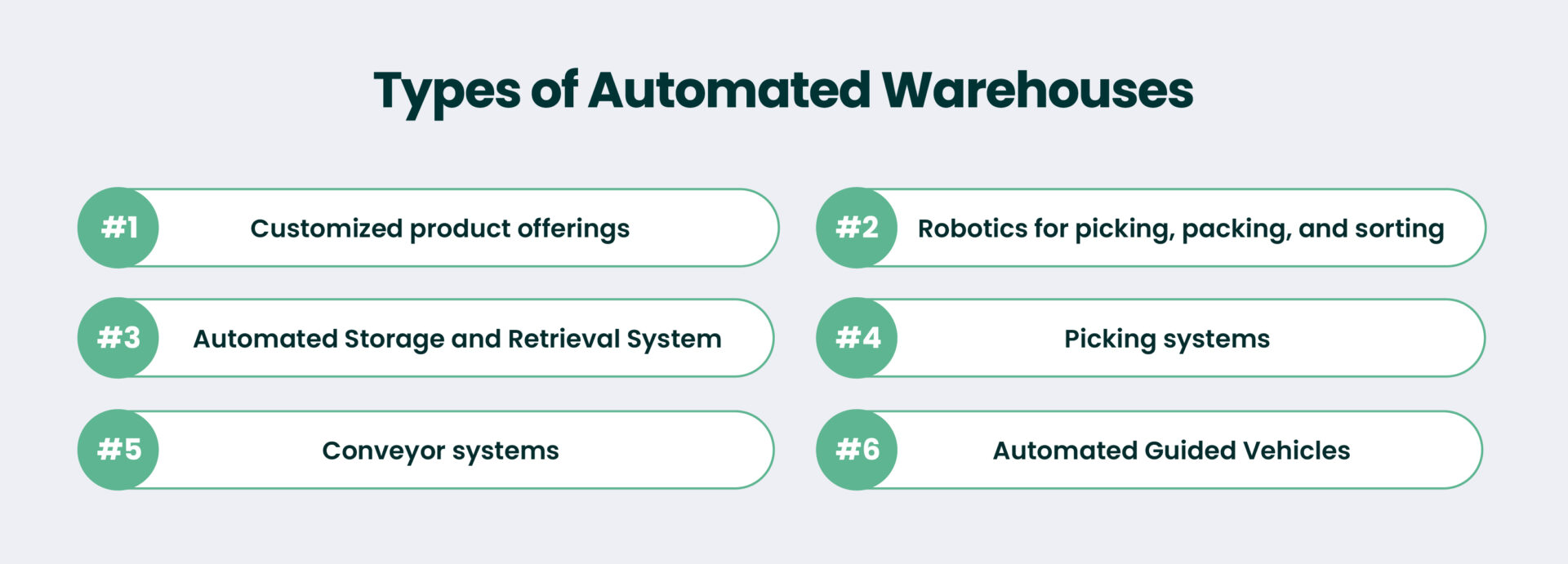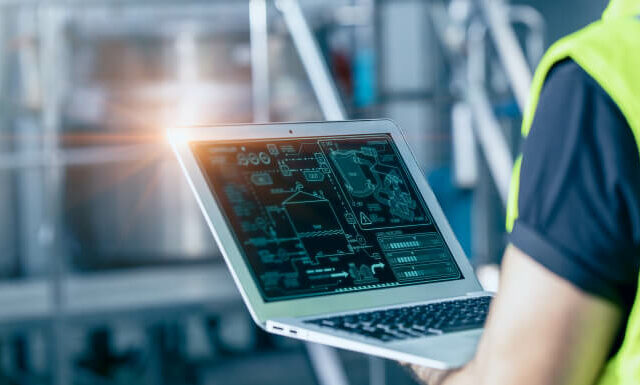Whether you’re a startup or an experienced business player, you’re likely familiar with the following situations. Limited warehouse space makes storing and retrieving goods a complicated process. The growing number of routine tasks eats up your time and effort. Your clients often complain about errors in product delivery and frequently send you messages regarding warehouse movements.
You’ve tried everything, from hiring extra workers to fine-tuning your operations, but the problems are repeating. For you as a business owner, this signals that it’s high time to transform your logistics and look for advanced tech solutions that can automate your processes.
Fortunately, warehouse automation systems offer solutions to limited space, human errors, and repetitive tasks. By integrating warehouse management systems, you can enhance the efficiency of your operations.
But which robotic warehouses should you choose, and what benefits can you expect from integration? We’ll cover that further down in our article. Just keep reading for more information.
What Is Warehouse Automation and Why Does It Matter
Warehouse automation technology robotizes various warehouse operations and processes, from inventory management systems to order fulfillment. The goal is to reduce costs, minimize human errors, and drive efficiency. Warehouse automation systems replace manual logistics operations with systems, machines, and industrial robots, offering significant benefits.
The history of warehouse management systems traces back to mechanization, with the introduction of steel conveyor belts in 1901 and forklift trucks in 1917. These early innovations revolutionized material handling, improving warehouse operations.
Over time, technology changed, introducing sophisticated systems like robotics and Automated Storage and Retrieval Systems. These advancements transformed warehouse operations and paved the way for supply chain digital transformation. Today, logistics management systems, ERPs, and warehouse automation systems streamline a company’s efficiency and help create new business opportunities.
Ready to revolutionize your logistics operations? Explore the power of smart warehouses with the Forbytes team.
Warehouse Automation Systems: Key Types Overview
Every day, more and more new intelligent warehouse technologies are emerging. These warehouse management systems have unique applications, features, and functions. But which type would be perfect for your business? Below, we’ve listed some of the most common warehouse automation systems. Let’s review them.
Automated warehouse systems for centralized management of operations
One of the most widespread types of warehouse management systems is software that centralizes management, enhancing logistics operations with equipment and robots. From transporting pallets on conveyor-like carts to optimizing storage with cube systems, warehouse automation improves how space is used.
Intelligent automation systems cater to various industries, from retail and food to sporting apparel and healthcare. The key is to consider a company’s specific needs and meet them by automating warehouses.
Automated sortation systems
Today, warehousing systems are advanced and supercharged by robotic arms and drones. These automated sortation systems can pick, pack, and sort items. They’re also efficient in performing warehouse operations and routine tasks. While they can’t replace human workers, they can serve as helpful assistants, ensuring accuracy and boosting productivity. Another advantage is better use of warehouse space; automation systems can optimize storage layouts and use vertical space more effectively, helping businesses store more goods without expanding their footprint.
For example, certain robots powered by AI and machine learning are truly intelligent. They can calculate the most efficient routes and transport goods. AI in logistics suggests that robots will soon handle more sophisticated tasks.
Automated Storage and Retrieval System (ASRS)
Another type of warehouse automation technology commonly used by companies is ASRS, which is based on computer-controlled machines and can store and retrieve items from storage locations.
ASRS allows for the efficient use of space by stacking items vertically. This system also enhances inventory management by reducing errors and speeding up order fulfillment.
Picking systems for reduced workloads
No doubt, you can’t completely root out manual picking, but you can automate the process by using picking systems. Pick-to-light systems, digital picking, and voice-directed systems are warehouse solutions that can reduce your workload.
In large warehouses, fully automated systems can handle picking without human intervention and optimize operations where manpower is limited. These technologies are often powered by warehouse automation software that connects all systems and coordinates picking tasks in real time. In large warehouses, fully automated systems can handle picking without human intervention and optimize operations where manpower is limited.
Conveyor systems for transporting goods
Today, the majority of robotic warehouses are equipped with conveyor systems. They transport goods across the warehouse, ensuring a smooth workflow and connecting various technologies. Conveyors have control systems and sensors to manage goods more efficiently.
They’re common in manufacturing, distribution, and warehouses to robotize processes and make them more efficient. These systems handle various products and help optimize productivity in supply chain operations.
Automated Guided Vehicles (AGVs)
To transport materials around the warehouse, companies opt for AGVs. These are mobile robots that use advanced navigation systems and follow predefined paths to move goods from one place to another. AGVs are good assistants as they reduce the reliance on humans.
AGVs are used in manufacturing, warehousing, and distribution to make handling goods easier, faster, and cheaper. Different types of Automated Guided Vehicles, like forklift AGVs and pallet AGVs, are designed to perform specific tasks.
Remember that the choice of a smart warehousing system depends on warehouse size, product features, and operational requirements. As a rule, companies combine multiple automation solutions to meet a broader range of specific needs.
Download Forbytes’ guide “How to Integrate Automated Warehouses” and make the first step towards a more efficient, cost-effective, and future-ready logistics operation.
Top 5 Must-Have Features of Automated Warehouses
Every automated storage system is unique and has its specific characteristics and functions. However, some universal features unite them and encourage companies to opt for advanced warehouse automation. Here’s a list of them:
- Scanning: Computer-controlled storage solutions are good scanners for inventory, showing high precision and accuracy. These robots roam warehouses to scan inventory, allowing workers to provide real-time updates. This kind of digital automation not only reduces manual errors but also speeds up inventory checks and improves decision-making with accurate, up-to-date data.
- Real-time inventory: Robotic software can show the exact location of each crate as it moves through the system, ensuring efficient handling and adapting to the order of items. With machine learning techniques, these systems can also predict inventory needs, spot patterns in stock movement, and continuously optimize storage and retrieval strategies.
- Metrics: Intelligent systems can automate data collection, which can be uploaded to various apps. This assists in understanding the warehouse environment, making it much easier to identify areas for improvement.
- System integration: System integration is a core feature of automated warehouses, allowing the entire system to function cohesively. For example, robots can be connected to a Robotic Management System (RMS) that gathers product data and identifies what needs to be picked and shipped.
- Mobile system: Intelligent systems are mobile, implying they can handle operations without a physical or electromechanical direction. They’re designed to adapt to dynamic warehouse processes like receiving, put-away, picking, packing, and shipping while minimizing delays and human intervention.
Automated warehouses have features that make logistics operations more efficient. From advanced scanning capabilities to real-time inventory tracking and seamless system integration, these features of automated warehouses bring many benefits to businesses that opt for them.
Lately, we’re also seeing a shift toward AI-driven robotics, predictive analytics, and IoT-enabled systems that offer even deeper insights and faster response times. Cloud-based warehouse management systems and mobile-friendly interfaces are also on the rise, helping teams stay connected and make smarter decisions on the go. These trends are shaping the future of logistics and giving businesses a competitive edge.
Email us to discover how robotic warehouses can transform your operations. Take the next step towards optimizing your logistics processes today.
See How Automated Warehouses Can Boost Your Business
According to Statista, the global warehouse market was valued at over $23 billion and is expected to reach $41 billion by 2027, with an annual growth rate of about 15%. The rise in online shopping has driven the demand for automation solutions.
The situation in the market proves that more and more businesses are opting for automated warehouses. By selecting the right solution, you can meet current challenges and streamline operations, but that’s not all. Here are the benefits you can receive by automating your supply chain.
Improved work efficiency
The implementation of automated warehousing systems systematizes complex, time-consuming tasks. As a result, warehouse automation enhances productivity and work efficiency.
For example, a warehouse system that operates 24 hours a day ensures the steady functioning of logistics operations, regardless of employees’ work schedules and performance. Additionally, it’s challenging for people to work in freezers and refrigerators for a long time. Therefore, automation solutions can replace employees by ensuring their safety and maintaining high productivity. Autonomous mobile robots (AMRs) are especially useful in these environments; they can navigate warehouse floors independently, transport goods efficiently, and operate in conditions that are unsafe or uncomfortable for human workers.
Saved space and less human intervention
Automated warehouse systems maximize space by storing goods on high shelves, using machine-based warehousing, and contributing to safe and efficient space utilization. Cube storage is ideal for space concerns, stacking items efficiently to minimize wasted vertical space.
Automated warehouses reduce the need for human intervention, especially when there is a lack of human resources. As a result, companies achieve fully automated operations and less dependence on people.
Inventory visibility
Automated warehouse systems contribute to the visibility of inventory management. Thus, a company can estimate supply and avoid backorders, which leads to high customer satisfaction. Using warehouse automation ensures visibility at the location and helps avoid situations where inventory can be lost or misplaced.
By working in conjunction with the enterprise ERP, warehouse management systems help make more informed decisions about which products to sell to increase revenues.
Reduced error rate
E-commerce frequently deals with customers who complain about receiving the wrong orders. For online stores, this damages their reputation and leads to the loss of clients. Warehouse automation helps avoid these issues by improving order accuracy and eliminating pick and pack errors.
Undoubtedly, warehouse automation systems can’t be 100% accurate, but they can significantly reduce the error rate. Automated software can quickly identify and correct mistakes. While not perfect, these systems are nearly flawless when it comes to picking operations.
The Challenges of Warehouse Automation and How to Handle Them
Warehouse automation can do wonders for your business: streamline workflows, boost efficiency, and cut costs. But let’s be honest: it’s not all plug-and-play. Like any big shift, it comes with a few bumps in the road. Here’s what you might face, and how to be ready for it.
High upfront costs
Getting started with automation isn’t cheap. You’ll need to invest in tech, equipment, and possibly hire outside experts to help. For smaller businesses, that can feel overwhelming. The upside? Most companies see a solid return on investment once the systems are up and running, through faster operations and higher sales.
Complex integration
Automation tools don’t work in a vacuum. They need to connect with your warehouse management software, your inventory systems, and sometimes even your ecommerce platform. That means careful planning and, ideally, someone who knows how to make everything talk to each other.
Specialized skill requirements
Automated warehouses need people who know how to run the tech. That includes maintaining, repairing, and troubleshooting when something goes wrong. Finding these skilled workers and keeping them can be tough, especially if you’re in a competitive labor market.
Technology moves fast
One of today’s “latest and greatest” systems could feel outdated in just a few years. When choosing a solution, look for something scalable and easy to upgrade. Future-proofing matters.
Want to future-proof your warehouse without the growing pains? Plan ahead, get expert support, and involve your team every step of the way. Automation isn’t about replacing people; it’s about empowering them with better tools.
Need help automating your warehouse? Get in touch with us, and we’ll find the right solution for your business.
Ready to Automate Your Warehouse Management System?
All in all, warehouse automation plays a vital role in modern warehouse management. By reducing human involvement in logistics, warehouse automation systems contribute to rapid, seamless order fulfillment, which is crucial for meeting clients’ expectations. Investing in these advanced technologies helps companies keep pace with evolving demands.
At Forbytes, we offer transportation and logistics software development services and can automate your logistics operations. By implementing a robotic warehouse, we can enhance your work and cost efficiency. That’s why we recommend considering this integration to address your business-specific needs and challenges.
Ready to automate your warehouse management? Contact our team and get benefits from your streamlined logistics operations.












